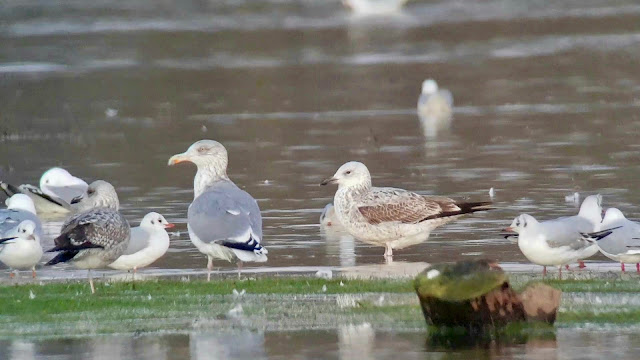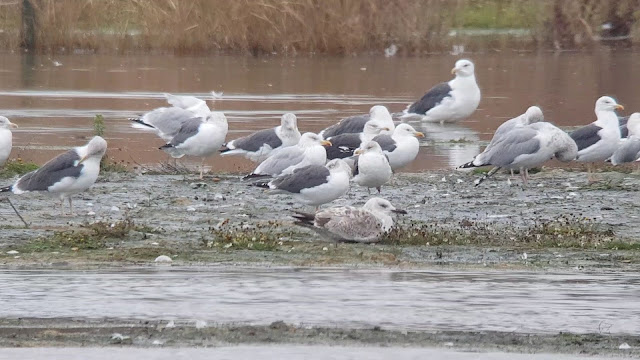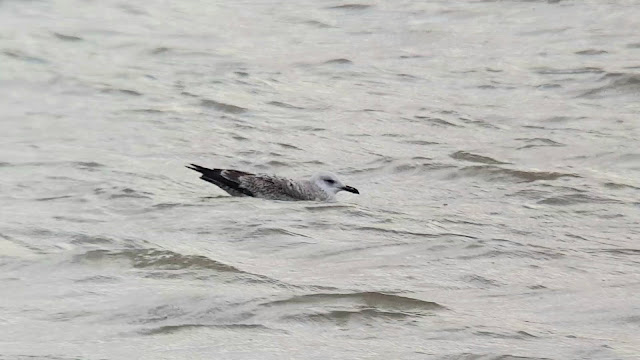My primary target was Caspian gull, an evocative species that's also a realistic prospect on a winter's day gulling. This was an exceptional year for me, mainly due to the increased gulling effort (during the winter I would be out at a roost or landfill site almost every day), and I saw 56 individual birds - 18 in London and 38 in Oxfordshire. As well as the Caspian gulls, other notable birds included a putative hybrid Ring-billed x Lesser Black Backed gull, two Kittiwakes and two Little gulls (with the latter two species being scarce birds at a county level) - as well as several Oxfordshire Mediterranean gulls and countless Yellow-legged gulls. Sadly, this was the second year in a row where I failed to find a white-winger, although I enjoyed good views of a juvenile Iceland gull at Appleford Gravel Pit. With signs of an influx already underway, and promising weather predicted, let's hope that the first few weeks of 2021 delivers one of these beautiful Arctic gulls.
Given that this first blog post is a summary of my 2020 finds I have decided to illustrate all the Caspian gulls that I saw, as I managed to obtain photographs of every single bird. I have divided the individuals into two categories - "Classic birds" and "Non-classic birds", with a third category "Hybrids", not included in the overall total. For birds that I only saw once I have given the date but most were seen multiple times. There may be some duplication in returning birds that have aged a year between the two winter seasons, and I have speculated that this may be the case for a couple of the birds.
Classic birds - 44 individuals
These birds show all the expected features, and whilst it is impossible to definitively say that they do not contain genes from other "species", equally there are no traits that actually indicate a hybrid origin. No problem accepting any of these individuals as pure Caspian gulls.
First-winters - 16 individuals
Bird 1 - Port Meadow, January-February. Pristine.
Bird 2 - Port Meadow, January-February. Large bird, probably male with a massive bill. This bird was also seen by Ian Lewington at Blenheim on 8th January.
Bird 3 - Port Meadow, 1st February.
Bird 4 - Appleford Gravel Pit and Farmoor Reservoir, September. Massive bird, absolutely dwarfing the Yellow-legged gull.
 |
| Appleford |
 |
| Farmoor |
Bird 5 - Farmoor Reservoir, 27th September.
Bird 6 - Appleford Gravel Pit, October-December. Although this individual displays well-marked greater coverts, this sort of minor chequering is apparently within variation for pure birds. Note how this pattern is restricted to the inner greater coverts and also there is still solid brown at the base of the feather.
Bird 7 - Appleford Gravel Pit and Farmoor Reservoir, October to November. The same bird was seen by Gavin Haig in East Bexington, Dorset on 5th October, Ian Lewington at Didcot Landfill, Oxfordshire on 17th October, and John Lynch in Newton Leys, Buckinghamshire on 22nd November. Good example of an unringed bird being tracked across the country based on distinctive plumage features, and a really stunning example as well - a large bird that's probably a male. Personal favourite Casp of 2020 and one of the all time greats...
 |
| Farmoor |
 |
| Farmoor |
 |
| Farmoor |
 |
| East Bexington. Courtesy of Gavin Haig |
Bird 8 - Port Meadow, 24th November. Initially picked out by Ollie Padget - this bird has also been seen at the beginning of 2021.
Bird 9 - Appleford Gravel Pit, December. Unusually advanced bird.
 |
| Courtesy of Isaac West |
Bird 10 - Appleford Gravel Pit and Port Meadow, December.
 |
| Port Meadow. Courtesy of Adam Hartley |
 |
| With first-winter Yellow-legged gull in foreground |
Bird 12 - Rainham Tip, December.
Bird 13 - Jolly Farmers, 26th December. Really nice, classic bird originally found by Rich Bonser.
Bird 14 - Jolly Farmers, 26th December. Large and aggressive - also strangely dumpy-looking, with short legs.
Bird 15 - Rainham Tip, 29th December. This dark, swarthy individual was initially picked out by Dante Shepherd - blunt bill, but otherwise classic.
Bird 16 - Rainham Tip, 31st December. This bird has also been seen by others at Jolly Farmers. Has a really neat scapular pattern - dark centres with wonderful pale borders.
Bird 1 - Erith Pier, 9th January.
Bird 2 - Port Meadow, 23rd January.
Bird 3 - Port Meadow, 12th February.
Bird 4 - Port Meadow, 25th February.
Bird 5 - Farmoor Reservoir, 1st October.
Bird 6 - Appleford Gravel Pit, October-November.
Bird 7 - Port Meadow and Farmoor Reservoir, November-December. The same bird was also seen at Cassington Gravel Pit in November.
 |
| Farmoor |
Bird 8 - Appleford Gravel Pit, 10th December. This bird was also seen at Appleford in October by Ian Lewington.
Bird 9 - Appleford Gravel Pit, 14th December. This bird was yellow-ringed but I couldn't read the code. Takes the "ugliest Casp of 2020" prize - I usually find that Casps have a subtle beauty about them, but not this guy... had nice P10 mirrors though.
Bird 10 - Appleford Gravel Pit, 17th December.
Bird 11 - Rainham Tip, 23rd December. Polish-ringed P:2K6. Full life history and sightings map below.
Bird 1 - Port Meadow, 15th January
 |
| Appleford |
Bird 3 - Port Meadow, 1st February. This bird was picked out by Adam Hartley whilst we were doing the roost.
 |
| Comparison of primary pattern between birds 2 and 3. Note that bird 2 has a tiny mirror on P9. |
Bird 4 - Appleford Gravel Pit and Port Meadow, October-December.
 |
| Appleford, October |
 |
| Appleford, December |
Bird 5 - Appleford Gravel Pit, 28th November. Quite retarded with retained median coverts.
Bird 6 - Appleford Gravel Pit, December. This is an interesting bird, I have not seen a third-winter with such extensive P10 tongues before.
Fourth-winters - two individuals
Bird 1 - Appleford Gravel Pit and Farmoor, November-December. This bird was first seen at Didcot Landfill by Ian Lewington a couple weeks before I first saw it at Appleford. Large bird.
 |
| Farmoor |
 |
| Farmoor |
Bird 2 - Appleford, 17th December.
Adults - 9 individuals
Bird 1 - Port Meadow, January-February. Small, thin-billed bird - presumably a female.
Bird 2 - Appleford fields, January-February. Green-ringed bird, but failed to read the ring on the two occasions I saw it. Quite a prominent gonys on this bird - male?
Bird 3 - Didcot Landfill, 7th February.
Bird 4 - Farmoor Reservoir, 10th November. This bird had some dark subterminal markings on the bill, but I couldn't detect any signs of immaturity in the plumage that might indicate a fourth-winter.
 |
| White arrow indicates tongues on underside of primaries - note that P9 is folded over P10 |
Bird 5 - Appleford Gravel Pit, December.
Bird 6 - Appleford Gravel Pit, December. Also seen by others at Didcot Landfill.
 |
| Appleford |
 |
| Didcot. Courtesy of Roger Wyatt |
Bird 7 - Rainham Tip, 21st December. With injured face.
Bird 8 - Rainham Tip, 22nd December. Perhaps slightly more black than one would expect on P10, but although it never gave a wing flap I can just about see the tip of the white tongue poking out from underneath the tertials, and was a classic Casp in every other respect.
Bird 9 - Rainham Tip, December.
Non-classic birds - 12 individuals
First-winters - 10 individuals
Bird 1 - Port Meadow, January-February. OK-looking, but mucky underwing and a bit of a Herring-y expression.
Bird 2 - Port Meadow, 27th February. A bit worse than the above bird, note residual head streaking, short bill and heavy anchor markings on the scapulars. But still the Casp facial expression is there.
Bird 3 - Appleford Gravel Pit, September. Polish-ringed P:UM8 - I only saw this bird briefly and failed to obtain any photos but luckily Ian Lewington saw it well at Didcot Landfill. Note mucky underwing and head, together with greater covert chequering.
 |
| Courtesy of Ian Lewington |
 |
| Courtesy of Ian Lewington |
Bird 4 - Appleford Gravel Pit, October. This bird had perfect Casp wings with a great white underwing, advanced moult, nice tertials, but Herring-like scapulars, and slight head streaking. Also seen by Ian Lewington at Didcot Landfill.
 |
| Appleford |
Bird 5 - Farmoor Reservoir, 9th November. I've included this bird here simply because at 500m range and in the failing light it was impossible to rule out a hybrid. It was clearly a Caspian-type gull - it looked OK and had an interesting bill deformity with crossed-over tips. Really small round head as well. From these blurry images the ends of the greater coverts seem to have quite a bit of white on them, but still a clear brown band at the base.
Bird 6 - Erith Pier, 20th December. Really good Casp plumage, but that head/bill combo is a bit off-putting. Also seen by Jamie Partridge at Rainham Landfill.
Bird 7 - Rainham Tip, 21st December. Again "fine", but quite a dark head, bit of greater covert chequering...
Bird 8 - Rainham Tip, 21st December. Looked a bit better than this in the field, but still really borderline. Heavily bleached already.
Bird 9 - Rainham Tip, 22nd December. Nice advanced covert and tertial moult, but short bill and a slightly streaky head. Bill at least manages to be quite thin and pointy, and again note the Casp facial expression.
Bird 10 - Rainham Tip, 31st December. Another advanced bird. Didn't really get a good look at it hence why it's going in this section. Looked nice - the greater coverts have some chequering and I can't see a solid brown base to the feathers, but probably within variation. Hard to call birds as distant as this, especially without seeing them fly.
Second-winters - 1 individual
Port Meadow, January. A puzzling bird, with very good plumage (though a bit of residual head streaking) including a nice P10 mirror, but the structure seems totally wrong and it didn't really give a Casp feel. The bill was tiny. Maybe it's a small female Caspian gull, or a hybrid with... what exactly?
Third-winters - 1 individual
Rainham Tip, 29th December. Another bird picked out by Dante Shepherd. I think the jizz looks very good for Caspian gull, but the amount of black in the wing tip is concerning. The P10 mirror is small, it lacks a P9 mirror and in most third-winters I would expect to see some development of tongues on the underside of the primaries, forming a curved pattern cutting into the black (compare primary patterns of third-winters above). I don't really see this here, with the shape of black looking more wedge-shaped, cutting in from the leading edge of the wing like a Yellow-legged gull. I suspect that this is within variation of Caspian gull, possibly even an individual from the Eastern end of the range (it also had a very dark mantle), but I have included it here as a hybrid could also produce these features.
Hybrids
I saw a large number of probable hybrid gulls this year so I have only illustrated a couple of case studies below. First winters were particularly numerous, but I rarely bothered to photograph them.
Second winters - 1 individual
Port Meadow, 15th December. Appeared somewhat like a Caspian gull, but wrong structure, wrong facial expression, mantle colour too pale, too much head streaking (especially around eye) and no P10 mirror. To my eye, the tertial and greater covert pattern could be within variation for either Caspian or Herring gull.
Sub-adults - 2 individuals
Appleford fields, 7th November. This bird had dark eye and a thin, desaturated bill, as well as a small amount of pencil streaking on the nape contrasting with a white head (good for Caspian gull at any age!) - but the underside of P10 is way off for a pure bird, having far too much black - adults and fourth winters should show a much longer P10 tongue than this. Note also the rather prominent subterminal band on P10, which is commoner in subadult birds.
Appleford Gravel Pit, 10th December. This bird had an almost perfect jizz for Caspian gull, but suffers from the same problems as the bird above. It did, however, have a broad black band on P5.





































































No comments:
Post a Comment